In 2018, we published a three-part series on our blog discussing the key takeaways from our analysis of thousands of engagements on the Priori platform, including the frequency with which fixed fees vs. hourly rates are used in our marketplace, the average hourly cost of hiring an attorney, and how lawyers are compensated based on the number of years they have practiced.
The use of technology within the legal industry has continued to develop over the past two years; however, data continues to be an underused commodity for both in-house legal teams and law firms alike. At Priori, we’re focused on changing that, and we wanted to take this opportunity to update our 2018 analysis to reflect the latest rates data from our marketplace as of June 2020.
In running our analysis, we compared our data with industry averages from Clio’s most recent Legal Trends Report, which analyzed aggregated and anonymized data from tens of thousands of legal professionals in the United States. We hope these findings will be illuminating for both in-house legal teams and lawyers seeking to better understand fee structures across the profession.
Part 1. Cost of Hiring a Lawyer by Geography
The below table and graph compares the average hourly rates of the attorneys in Priori’s vetted attorney network with the industry average in metropolitan areas across the U.S.
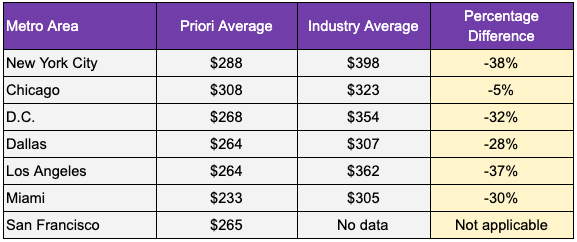
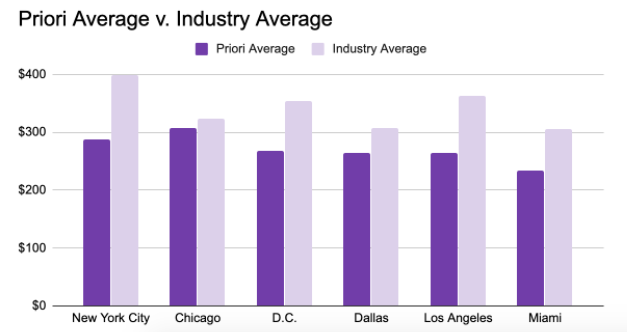
Key Takeaways:
-
Across the United States, Priori attorneys are consistently less expensive than the industry average1 in key metropolitan areas.
-
In New York City, the country’s largest legal market,2 Priori attorneys are 38% less expensive than the industry average.
-
In San Francisco, the average Priori lawyer charges $265 per hour. Clio’s report does not provide an industry average for San Francisco.
Comments:
In considering the above data, it is important to note that we do not have access to a complete breakdown of Clio’s geographic data by practice area and years’ experience, so we cannot definitively state the reason for the difference in rates. That said, Priori attorneys are vetted using a data-driven process that selects for attorneys with strong backgrounds and credentials — the types of attorneys that, all else being equal, are likely to charge higher rates than average for their experience. The Clio data also includes lawyers who serve individual clients and businesses, while business work comprises substantially all projects completed on Priori’s platform — and business legal work, in general, is performed at higher hourly rates than work for individuals. Taking those factors into account, in our view the fact that Priori rates compare so favorably with the industry averages across the U.S. highlights one of the benefits of our marketplace model: it creates competition, transparency and ease-of-comparison that drives down costs for in-house teams.
Part 2. Cost of Hiring a Lawyer by Practice Area
The below graph summarizes what Priori attorneys charge, on average, per hour for work performed in a number of different practice areas.
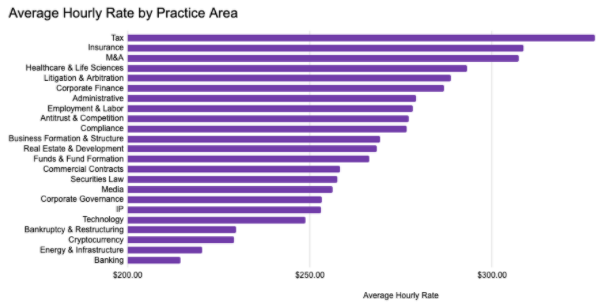
We also compared the average hourly rates for Priori network attorneys in key practice areas with the industry average listed in Clio’s Legal Trends Report.3

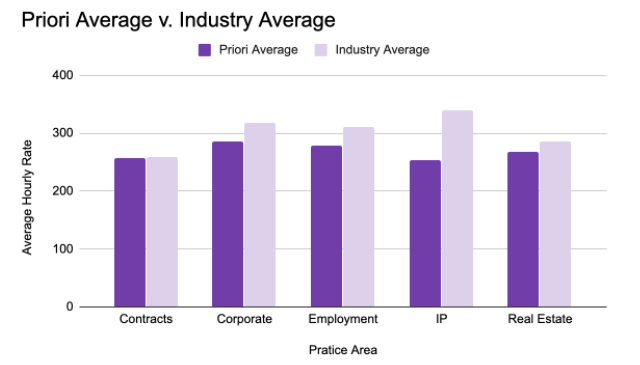
Key Takeaway:
-
Depending on the practice area, Priori attorneys charge between 1% and 34% less than the industry average, with the difference being greater for more specialized practice areas such as employment and IP.
Comments:
Similar to Part 1 (Cost of Hiring a Lawyer by Geography), we do not have access to a complete breakdown of Clio’s practice area data by geography or years’ experience, so we cannot definitively state the reason for the difference in rates across practice areas. However, the fact that a difference exists is in our view supportive of the argument that our marketplace model drives down costs because of the competition, transparency and ease-of-comparison the model promotes. This argument is consistent with our observations that the traditional methods of sourcing outside counsel, such as through personal connections or by approaching BigLaw firms, often leads to selection from a limited attorney pool that can result in overpricing. Technology platforms like Priori can help solve that issue.
Part 3. Rates Based on Years’ Experience
Turning to data relating to experience, the following graph shows the average hourly rates of Priori lawyers hired on the platform compared to their years of experience. This data includes lawyers in all practice areas and across the U.S.
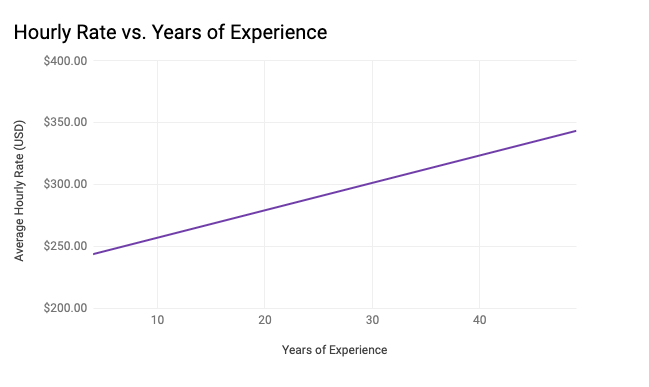
Key Takeaway:
-
Every ten years of experience adds approximately $23 to the average lawyer’s hourly rate on the Priori platform. This means that every additional year of experience adds ~ $2.30 to a lawyer’s hourly rate.
Comments:
In our view the most interesting aspect of this graph is that it shows that while clients do value years of experience when purchasing legal services, it is not valued as highly as one might expect.
Part 4. Flat Fees v. Hourly Rates
The following two charts show the frequency of flat fee billing compared with hourly rate billing across the legal industry and on the Priori platform.4
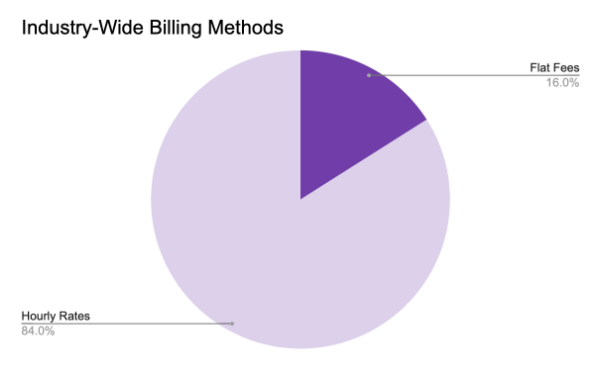
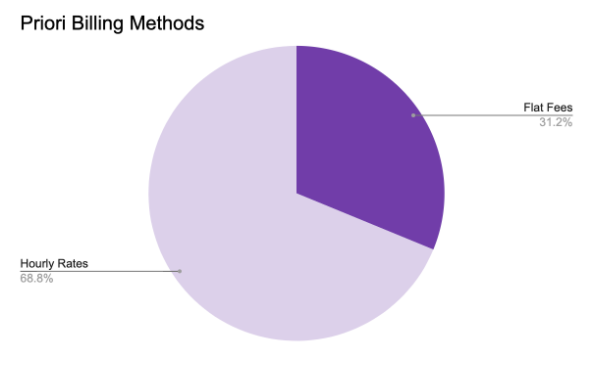
Key Takeaway:
-
Lawyers on the Priori platform offer flat fees in 31.2% of all engagements, meaning they are almost twice as likely to offer flat fee arrangements compared to the industry average (16%).
Comments:
The reason for the difference between Priori and the industry average may be explained by the fact that, in our experience, in-house legal teams are being increasingly pressured by what legal technology thought leader Richard Susskind describes as “the more for less challenge.” In other words, in-house teams are facing increased expectations on their output but are often provided with fewer resources to achieve their goals. As a result, in-house teams are increasingly looking to solutions like Priori to help make their legal spend more predictable. On our platform, when submitting an RFP in-house teams can select their preferred pricing model (whether hourly, fixed or other) and enter their budget range. We can then run an automated bidding process to source the attorneys and firms with the best pricing within the company’s budget range, saving the company both time and money when compared to traditional law firm solutions and resulting in more fixed fee projects being run through the Priori platform.
Conclusion
We hope you found this information helpful. At Priori, we strongly believe that marketplace platforms like ours help make hiring outside counsel easier and more cost effective through the use of data. That view is supported by the analysis in this article, which demonstrated that:
-
Across practice areas and geographies, Priori attorneys are consistently less expensive than the industry average.
-
Lawyers on the Priori platform are almost twice as likely to offer flat fee arrangements when compared to the industry average.
-
Under hourly billing arrangements, lawyers on the Priori platform receive an average of ~ $2.30 per hour extra for every additional year of experience, making Priori a great resource to find experienced attorneys for upcoming projects.
If you are interested in using Priori for an upcoming project or would like to find out more about our service, please contact Priori’s Client Director, Jon Karolczak (jon.karolczak@priorilegal.com). You’re also welcome to submit an RFP here at any time.
—
1. The “industry average” in this piece represents the amounts found in Clio’s 2019 Legal Trends Report, a comprehensive and exhaustive analysis using anonymized billing information from tens of thousands of lawyers. All prices in this piece are in USD and represent the cost per hour. Unless otherwise stated, “average” refers to the statistical mean.
3. These practice areas were partly chosen because they represent an overlap between Clio’s data and our own.
4. The industry average is taken from the 2017 Clio Legal Trends Report, as neither the 2018 or 2019 reports have the industry breakdown of flat fees versus hourly rates.
